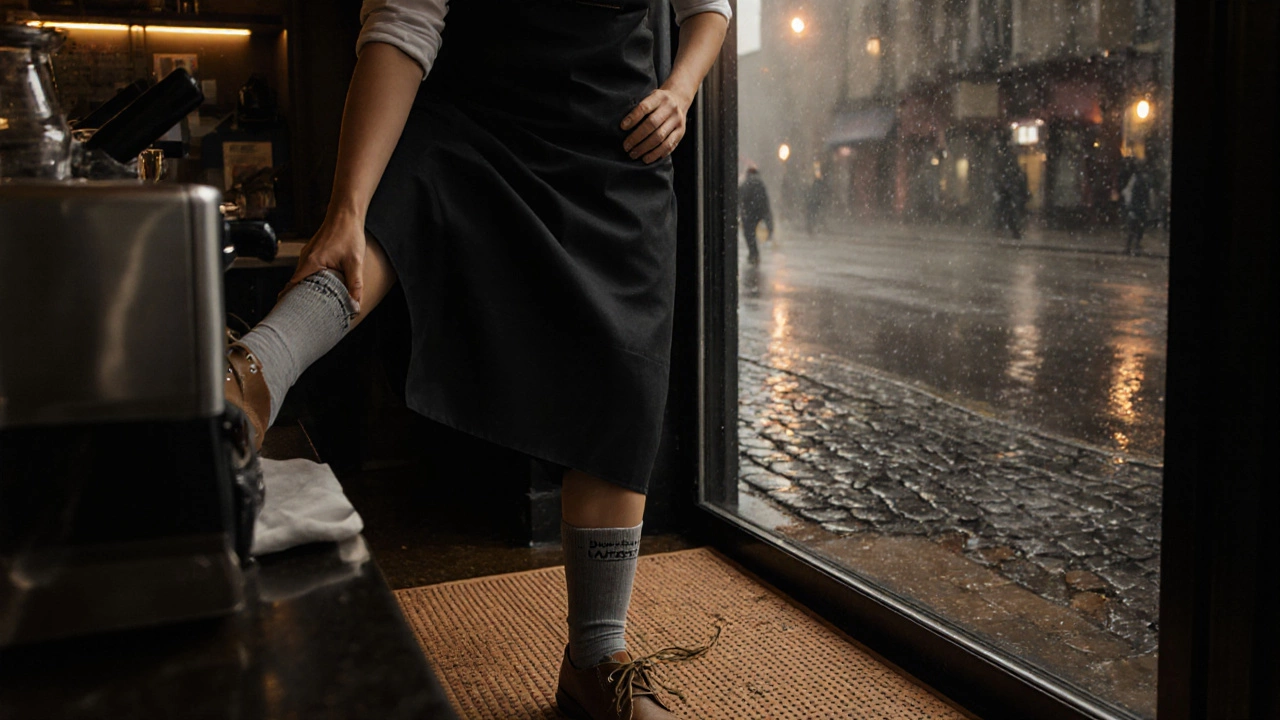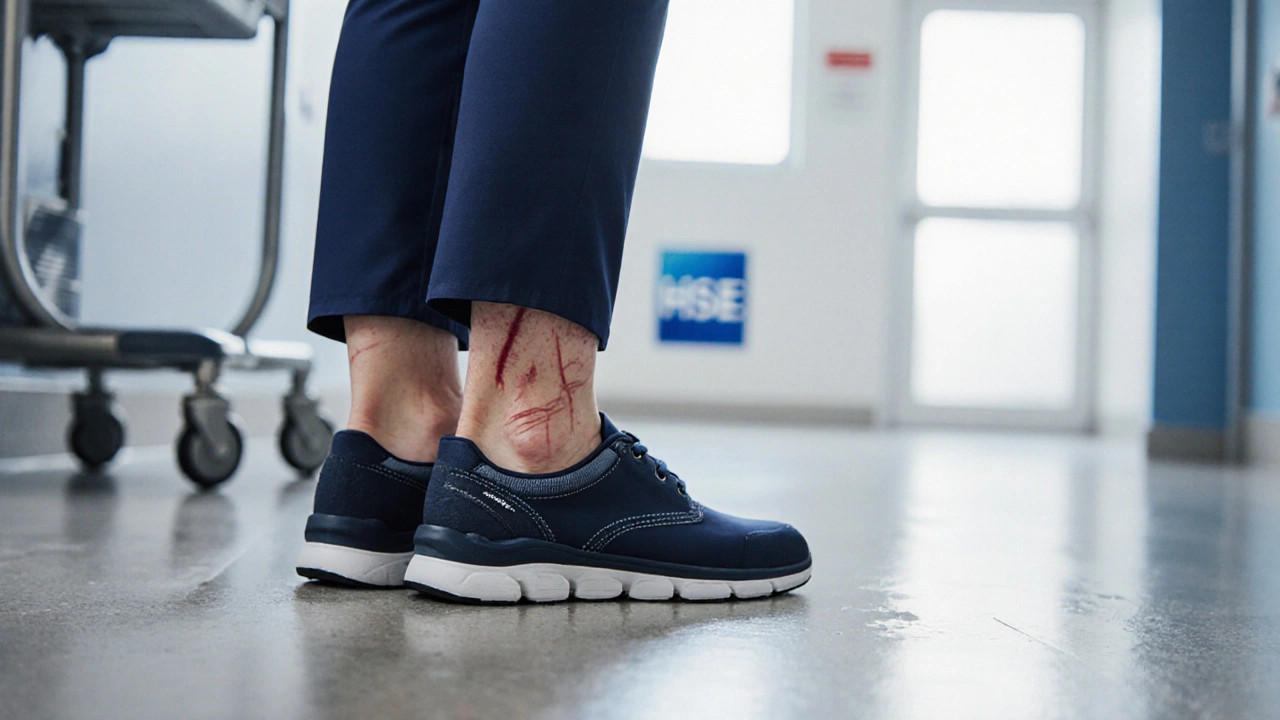Irish Work Shoe Selector
Find Your Perfect Work Shoes
Select your occupation, foot type, and budget to get personalized shoe recommendations for Irish working conditions.
Your Recommendations
Recommended Shoes
Why these shoes?
Your selected shoes are ideal for your occupation and foot type.
Ever wonder if standing for 12 hours is hurting your feet? In Ireland, a full day on your feet is common in hospitals, retail on Grafton Street, or hospitality in the Temple Bar district. The good news is you don’t have to live with aches - the right shoe, a few simple habits, and local resources can keep you moving comfortably.
What Happens When You Stand All Day?
Prolonged standing is a condition where a person remains upright for extended periods, often exceeding typical work shifts. It puts continuous pressure on the calves, arches, and heels. Over time, the body’s natural shock absorbers wear down, leading to swelling, reduced blood flow, and muscle fatigue.
- Blood pools in the lower legs, increasing risk of Venous insufficiency.
- Plantar tissue overstretches, which can trigger Plantar fasciitis.
- Joint compression may aggravate osteoarthritis in the knees and hips.
These effects aren’t just theoretical - Irish physiotherapists at the HSE report a 30 % rise in foot‑related complaints during the busy winter sales period.
Who in Ireland Is Most at Risk?
From Dublin’s bustling city centre to Galway’s tourist‑packed streets, several professions involve long standing:
- Healthcare workers: Nurses and orderlies in hospitals like Mater and St. James’s spend up to 12‑hour shifts on hard‑floor operating theatres.
- Retail staff: Sales assistants on Grafton Street or the Liffey Valley Mall often stand behind counters for entire weekends.
- Hospitality crew: Bartenders in the Temple Bar and servers in rural B&Bs juggle constant movement during busy dinner service.
- Public transport employees: Bus drivers and ticket collectors on Dublin Bus routes experience long periods of standing while waiting for passengers.
If you fall into any of these groups, the advice below is especially relevant.
Choosing the Right Work Shoes for Irish Conditions
Irish weather can be wet, and city streets are often uneven - think cobblestones around the historic Dublin Castle or slick tiles in a Cork café. A good pair of work shoes should handle moisture, provide grip, and still give your feet the support they need.
| Brand/Model | Cushioning | Arch Support | Water‑Resistant | Typical Price (€) | Best For |
|---|---|---|---|---|---|
| Clarks Un Costa | High (EVA midsole) | Medium (removable orthotic) | Yes (treated leather) | 120‑150 | Retail & office |
| Dubarry Grafton | Medium (memory foam) | High (integrated arch) | Yes (rubber outsole) | 140‑170 | Hospitality & outdoor |
| Rockport World Tour | High (AirTec technology) | Medium‑High | No (leather) | 130‑160 | Healthcare |
| Skechers Workshire Relaxed | High (Ultra Go cushioning) | Low‑Medium | Yes (mesh) | 90‑110 | Students & part‑time staff |
| Irish Made Hibernia Boots | Medium | High (custom insole) | Yes (leather‑treated) | 180‑210 | Construction & heavy‑duty |
When you shop at stores like Schuh Dublin or the local branch of Clarks, ask for the “orthotic‑ready” version - it lets you slide in custom Ergonomic insoles later on.
How Ergonomic Insoles and Orthotics Help
Even the best shoe can fall short if your foot shape is unusual. About 15 % of Irish adults have high arches, while another 20 % have flat feet. Both conditions benefit from Orthotics or supportive insoles that redistribute pressure.
- High arches: Need extra cushioning under the heel and forefoot.
- Flat feet: Require firm arch support to prevent collapse.
- Overpronation: A medial post (a thickened side of the insole) corrects the roll‑in.
Brands like Superfeet and Sole are stocked in Dublin’s The Sports Shop and Cork’s Specialist Sports store. Many podiatrists at the HSE also offer prescription‑grade orthotics for a modest fee.
Quick Wins: Simple Changes That Cut Fatigue
If you can’t replace your shoes overnight, these tweaks make a noticeable difference:
- Anti‑fatigue mats: Place them at checkout counters or behind kitchen stations. Cork flooring from Irish suppliers blends well with décor and reduces impact.
- Micro‑breaks: Every 60‑90 minutes, shift weight, roll your ankles, or do a quick calf raise. The Irish Cervical and Back Pain Society recommends a 2‑minute stroll in the staff breakroom.
- Stretching routine: Try the “dual stretch” - press your toes against a wall while leaning forward, then sit and pull your toes toward you. Hold each for 20 seconds.
- Hydration: Drinking water reduces swelling. Keep a refillable bottle from Irish brand Bóthar on your desk.
- Compression socks: Graduated compression (15‑20 mmHg) improves circulation, especially useful for nurses on the night shift.

Real‑World Irish Examples
At St. Vincent’s Hospital, the occupational health team introduced soft‑sole shoes and a mandatory 5‑minute foot‑stretch break each hour. After three months, reported foot pain dropped from 42 % to 18 %.
Retail chain Penneys piloted an “anti‑fatigue carpet” in their flagship store on Henry Street. Sales staff said they felt less sore after a 10‑hour shift, and turnover fell by 7 %.
If you work in a Dublin café, swapping your standard slip‑on for a Dubarry Grafton pair and adding a SupaFit insole can keep you upright through the morning rush and the late‑night coffee crowd.
Checklist: Is Your Footwear Up to the Task?
- Does the shoe have a cushioned midsole (EVA or memory foam)?
- Is there removable arch support for custom orthotics?
- Are the uppers water‑resistant or treated for Irish rain?
- Is the outsole slip‑resistant on wet cobblestones?
- Do you wear compression socks or insoles daily?
- Are you taking micro‑breaks and stretching regularly?
Tick all the boxes and you’re on the right track to beating the 12‑hour standing blues.
Frequently Asked Questions
Can I work a 12‑hour shift without pain?
Yes, if you wear supportive shoes, use orthotic insoles, and incorporate short breaks for stretching and circulation. Most Irish workers see a drop in pain after adopting these habits.
What price range should I expect for quality work shoes in Ireland?
A solid pair typically costs between €90 and €210. Brands like Clarks and Dubarry sit in the middle, while custom Irish‑made boots are at the higher end.
Are anti‑fatigue mats worth the investment for a small shop?
For a single employee, a simple cork mat (around €30) can cut leg fatigue by up to 30 %. It’s a low‑cost win, especially in wet Irish weather where floors become slippery.
How often should I replace my work shoes?
Most experts recommend swapping them after 6‑12 months of daily use, or when the midsole no longer feels springy. In Dublin’s rainy climate, check the outsole for wear every three months.
Can compression socks help if I have varicose veins?
Graduated compression (15‑20 mmHg) improves venous return and eases swelling. Irish nurses often wear them during night shifts; just choose a breathable, moisture‑wicking fabric.
